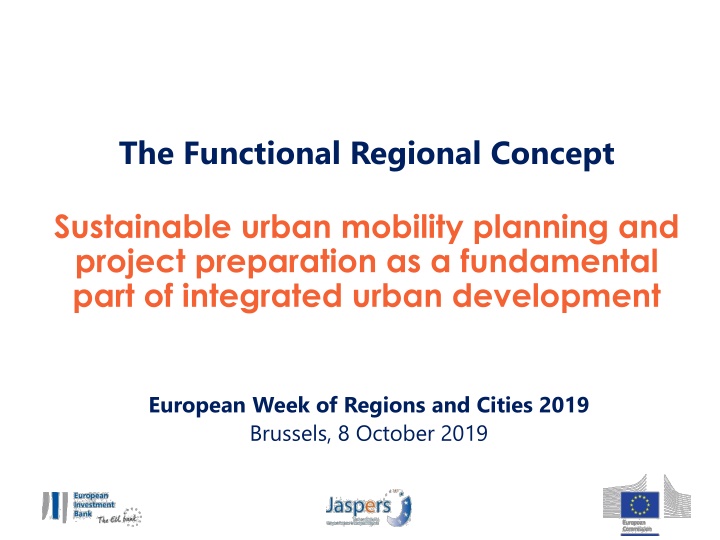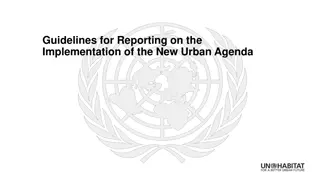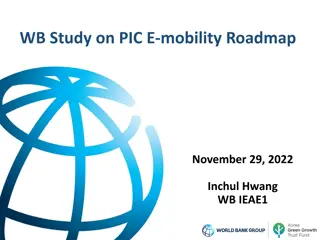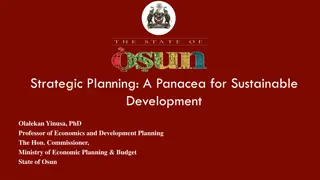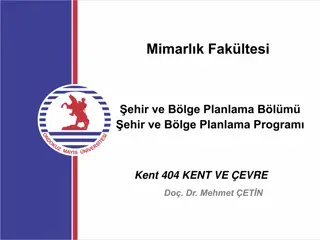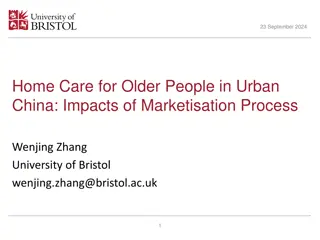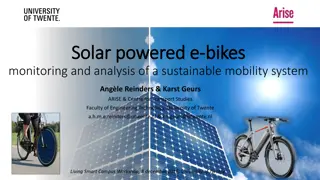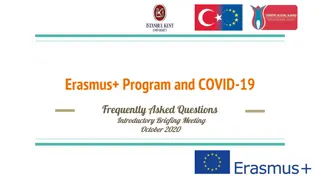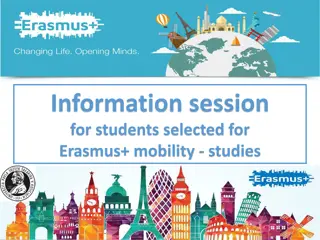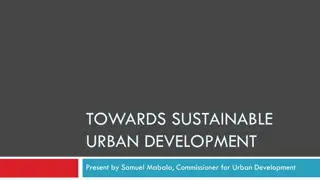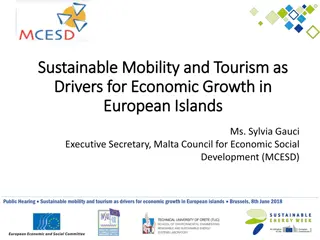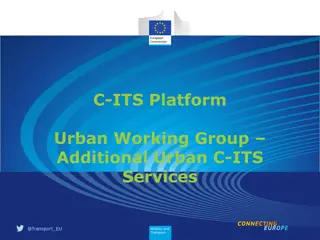Functional Regional Concept for Sustainable Urban Mobility Planning
The Functional Regional Concept emphasizes sustainable urban mobility planning as an integral part of integrated urban development. This concept aims to support economic and social growth by adjusting the transport system to various activities within a city. It focuses on sector/system sustainability, efficiency, and effectiveness for better project development, absorption of EU funds, and overall system performance. The transport planning process involves strategic development based on economic and social trends, covering inter-modality, functional regions, and stakeholder participation. It aims to create a continuous and independent process for long-term sector development. The concept incorporates the Sustainable Urban Mobility Plan (SUMP) at a broader level, focusing on mobility relationships and gravitational centroids within metropolitan areas.
Download Presentation

Please find below an Image/Link to download the presentation.
The content on the website is provided AS IS for your information and personal use only. It may not be sold, licensed, or shared on other websites without obtaining consent from the author.If you encounter any issues during the download, it is possible that the publisher has removed the file from their server.
You are allowed to download the files provided on this website for personal or commercial use, subject to the condition that they are used lawfully. All files are the property of their respective owners.
The content on the website is provided AS IS for your information and personal use only. It may not be sold, licensed, or shared on other websites without obtaining consent from the author.
E N D
Presentation Transcript
The Functional Regional Concept Sustainable urban mobility planning and project preparation as a fundamental part of integrated urban development European Week of Regions and Cities 2019 Brussels, 8 October 2019
Cities and Transport Transport is a result of economic and social activities > interventions on the transport system do not plan/design them but Adjust the transport system to them Support sustainable social and economic development Transport is (one of the main tools) to boost economic and social growth Traffic on the local level: Administrative system Health system Education system Trade Industry Solid Waste Waste Water Etc. 2
Some fundamental principles when developing projects A. Sector/System Sustainability/Efficiency/Effectiveness B. Absorption of available EU funds How to make systems better perform: more projects better projects (more & better absorption) OPEX CAPEX EU support National support Operations Maintenance INCOME Revenues Subsidies
The transport planning process (1) Answers to the questions: Operation Good projects need good strategies/plans Project Organization Infrastructure National Transport Strategy National and international traffic Transport Masterplans/ SUMPS Local and regional traffic Projects Technical Feasibility Study
The transport planning process (2) Transport Plan main principles Based (consequence) on economic and social developments Covering the whole sector (inter-modality) Homogeneous areas: Functional regions Medium-long term process Independent from funding Basis for further sector development - A continuous process Participation of relevant stakeholders Simple philosophy Data Analysis/Hypothesis Objectives Measures Projects 3 layers: Organisation Operation - Infrastructure Strategic Environmental Assessment 5
The Functional Regional concept (1) Incorporates the SUMP concept at a wider homogeneous area level - independent from administrative borders (based on traffic model): defined by mobility relationships focused on gravitational centroids could be a metropolitan area/agglomeration, Main reference for a (local/regional) transport plan -> can be overlapping FR defined in the National Transport Plan FR should be the main reference for local transport plans -> avoid smaller towns alone Inputs for the preparation of the National Transport Plan, complementing the national sectorial plans/analyses 6
The Functional Regional concept (2) Freight movements to be (possibly) considered in the analysis Transport as a result of economic and social activities FRC does not plan these activities Adjusting the transport system to them Supporting sustainable social and economic development Education Health Waste Transport Industry Tourism Trade
JASPERS supported SUMPs/Transport Plans: Slovakia SK - approach/methodology SUMPs are required for funding transport projects Common methodology was prepared taking into account several sources: Guidelines: Developing and Implementing a Sustainable Urban Mobility Plan (SUMP methodology) The Poly-SUMP Methodology: How to develop a Sustainable Urban Mobility Plan for a polycentric region (Poly-SUMP methodology) ToRs in some cities in Slovak Republic (2013 2015) Law regulation on spatial planning Recommendations of Jaspers Extent of SUMP is based on population cities with population over 50 000 and regions should prepare a full version of plan whereas other cities can prepare a little version of plan or can be part of the regional SUMP
Successful SUMPs in SK City of Bratislava Population: 432 801, metro area: 659 578 Previous master plan: list of wishes usable for land use plan purposes only, not for justification of projects not real transport strategy New master plan: prepared 2013 2015, incl. SEA, approved 2016 link between analysis, objectives and measures projects tested in transport model Example of the linkage between analysis/objectives/measures: Issue: Low travel speed of public transport Specific goal: Shift of transportation services to trams especially in the central area (except other with the goal to reduce emissions produced by traffic in the most burdened areas) by 2030 Measure: Preference of public transport in areas with high demand for transportation Result: All modernized tram tracks will be equipped with priority of trams at crossings; separate project improving signaling is being prepared
Bratislava SUMP main outcomes Main measures identified by the Plan: Priority of PT in areas of high demand for transportation (increase of comfort/reliability of PT travel) Priority of existing PT (bus lanes) Recommendation to realize selected proposals of the Territorial Plan of Bratislava Z KOS (base road network) - related to increasing the capacity of roads with dedicated lanes reserved for PT Connecting main tram radials with a second level PT system to absorb this demand Parking Policy P + R Parking Facilities Construction of integrated PT terminals ("TIOP") including suburb. railway Bike transport development Strong focus on a correct implementation of the Plan and its measures -> + follow-up Bratislava railway node study and Bratislava Regional Transport Masterplan
SUMP and real projects Bratislava Tram line number 1 to Petr alka crossing the Danube river - infrastructure and trams financed by ESIF projects supported by JASPERS 14
Conclusions (1) Romanian trains looks nice but are slower than a bicycle
Conclusions (2) An urban mobility plan/SUMP is A strategic document for pursuing transport/mobility goals related to socio-economic objectives and integrate local mobility with other planning documents A working framework for shaping intervention measures A long term commitment to ensure stability and continuity in the development of transport/mobility strategies A planning instrument to identify and solve deficiencies in the transport system and/or valorize positive experiences/opportunities, and eventually identify and select projects It is not (or should not be) A formal exercise to fulfill legal requirements A mere description of the status-quo A wish-list of projects disconnected from real needs of the society Necessary to plan beyond administrative borders ( functional regions/areas ) Necessary to ensure a correct implementation of the plan Romanian trains looks nice but are slower than a bicycle
JASPERS recent experiences on loc./reg. transp.plans/SUMPS Country CY CZ CZ HR HR HR HR HR HR Area Four Cities National Prague National Zagreb et al. Zagreb Rijeka Sibenik Osijek Beneficiary Ministry Ministry City Ministry Cities Railway et al. Cities Cities Cities Type Horizontal Guidance Horizontal Guidance City Agglomeration Horizontal Guidance Transport Masterplan covering the functional region around Zagreb Railway node study for the functional region around Zagreb Transport Masterplan covering the functional region around Rijeka Transport Masterplan covering the functional region around Sibenik Transport Masterplan covering the functional region around Osijek HR Dubrovnik Cities Transport Masterplan covering the functional region around Dubrovnik Transport node study for the functional region around Budapest Transport Masterplan covering the functional region between Western Hungary and Burgenland (AUT) Regional Plan combining multiple municipalities HU Budapest Ministry/City HU West.Hun/Burge nland Bucharest/Ilfov Regions RO Ministry/City Partnersh. Ministry/City Seven second-tier cities, each being a Regional Plan combining multiple municipalities Ministry Horizontal Guidance Ministry Horizontal Guidance City Transport Masterplan covering the area of Bratislava City Transport Masterplan covering the area of Kosice Bratislava region Region Transport Masterplan covering the area of the Bratislava region Bratislava Ministry/City/ railway National Ministries Support to MAs (for OPII & IROP) for the preparation of the EU-funded Transport RO Growth Poles RO SK SK SK SK SK National National Bratislava Kosice Railway node study for the functional region around Bratislava 17 SK
Many thanks! a.gonzalezsanchez@eib.org JASPERS
Successful SUMPs in SK (2) City of Kosice Population: 240 688, metro area: 555 800 Previous master plan: obsolete (prepared in 1984) New master plan: prepared 2014 2015 incl. SEA, approved 2016 based on national transport strategy link between analysis, objectives and measures projects tested in transport model accent on sustainable transport modes and also organizational and operational areas Some non-regret projects funded from EU funds were supported in Bratislava and Ko ice prior to developing new strategies All new projects must comply with new strategies
Some remarks from the SK experience It is necessary to promote importance of SUMP (it is useful not only for funding projects from EU funds, but sustainable strategy is important for all decisions in transport system) Good management during preparation of SUMP is a must An action plan with responsibilities and timeline should be included Implementation of the plan has to be managed and periodically evaluated Implementation team should be created during preparation of SUMP at the latest All measures should be implemented (not only those related with EU funding) Other actions are necessary in order to make SUMPs binding also for police and other local governments Updates of SUMP are necessary
